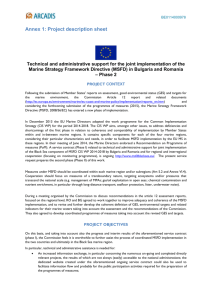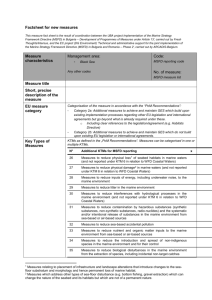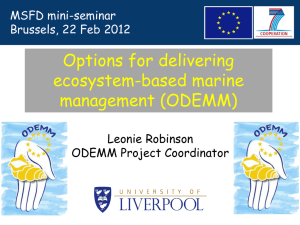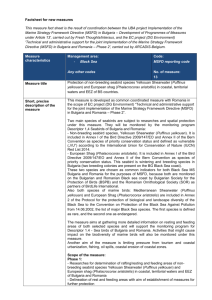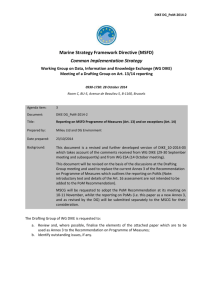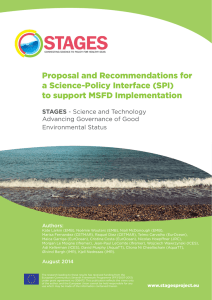Methodology on cost benefit assessment Black Sea
advertisement
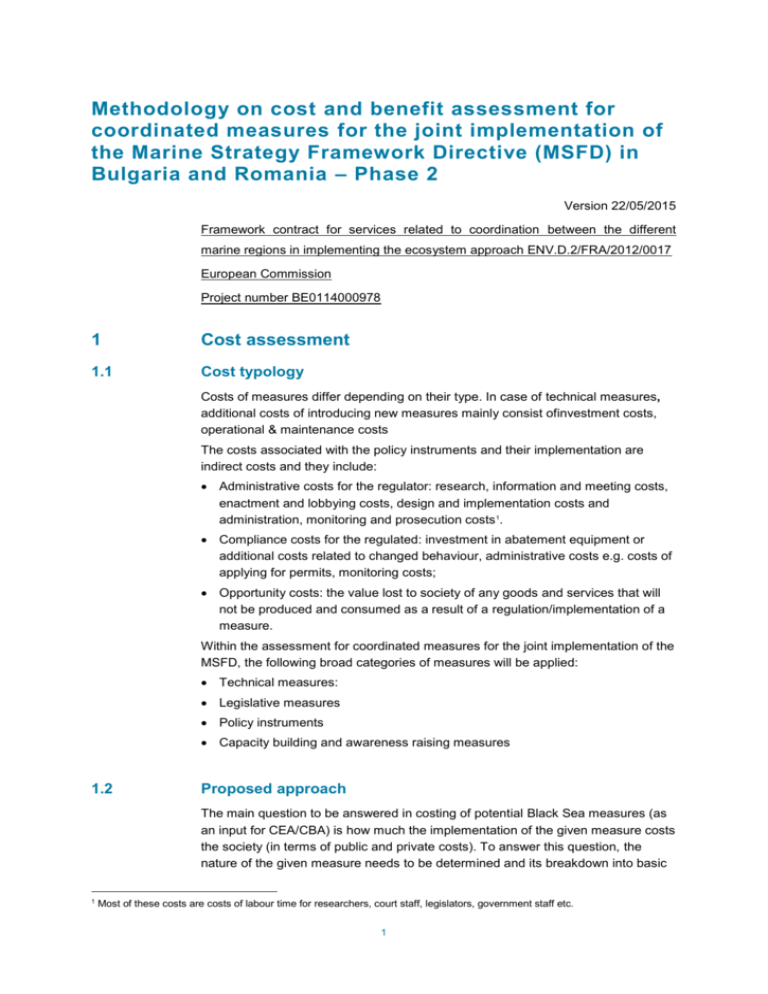
Methodology on cost and benefit assessment for coordinated measures for the joint implementation of the Marine Strategy Framework Directive (MSFD) in Bulgaria and Romania – Phase 2 Version 22/05/2015 Framework contract for services related to coordination between the different marine regions in implementing the ecosystem approach ENV.D.2/FRA/2012/0017 European Commission Project number BE0114000978 1 Cost assessment 1.1 Cost typology Costs of measures differ depending on their type. In case of technical measures, additional costs of introducing new measures mainly consist ofinvestment costs, operational & maintenance costs The costs associated with the policy instruments and their implementation are indirect costs and they include: Administrative costs for the regulator: research, information and meeting costs, enactment and lobbying costs, design and implementation costs and administration, monitoring and prosecution costs 1. Compliance costs for the regulated: investment in abatement equipment or additional costs related to changed behaviour, administrative costs e.g. costs of applying for permits, monitoring costs; Opportunity costs: the value lost to society of any goods and services that will not be produced and consumed as a result of a regulation/implementation of a measure. Within the assessment for coordinated measures for the joint implementation of the MSFD, the following broad categories of measures will be applied: Technical measures: Legislative measures Policy instruments Capacity building and awareness raising measures 1.2 Proposed approach The main question to be answered in costing of potential Black Sea measures (as an input for CEA/CBA) is how much the implementation of the given measure costs the society (in terms of public and private costs). To answer this question, the nature of the given measure needs to be determined and its breakdown into basic 1 Most of these costs are costs of labour time for researchers, court staff, legislators, government staff etc. 1 cost components and/ or inputs needed for implementation provided. In order to get insight in the different costs of measures and to assign values to it, we propose a 3 step approach: 1. Assigning cost components to measures 2. First rough assessment 3. More detailed assessment 1.2.1 Assigning cost components to measures Different types of measures require different types of cost input to be implemented. As an example, for legislative measures the main cost element consist of the time needed to draft the laws and administer them. Per type of measure (based on the 4 type category of measures above) we provide cost templates to be filled in during the Brussels May workshop (5-6/05). As a first step, the proposed measures should be subdivided into cost components and their temporal scale (one off; yearly costs, time period). Each cost component is shown here under with its specific cost indicators. Cost components Implementation costs for a law, regulation, … - Preparation (Planning, writing) - Consultation, Dealing with objections, - Finalisation (Approval and sign-off, advertising • Enforcement costs - Surface surveillance - Joint enforcement patrols with local officer - Aerial surveillance - Investigations/prosecutions • Negotiation costs - Planning & preparation - Drafting agreement & Ratification - Meetings with neighbouring MS - Travel & other costs • Management costs - Staff time (preparation, follow up) - Meetings with neighbouring MS - Travel & other costs Research costs - Research time 2 - Information and meeting costs - Alternative approach: costs of similar research projects Technical implementation costs - Investment costs - Operational costs - Maintenance costs Costs of stakeholder consultations - Staff time (preparation, follow up) - Meetings with stakeholders Communication costs - Advertisement - Staff time - Other administration costs Training costs - Preparation - Training material (courses) - Giving training Costs for assistance with voluntary agreements - Staff time (preparation, follow up) - Meetings with neighbouring MS - Travel & other costs Cost for awareness raising - Staff time (preparation, follow up) - Awareness raising material Sectoral costs - Investment & operational costs - Loss of added value - Loss of employment 3 1.2.2 First rough assessment Based on the breakdown of measures into cost components, a first rough cost indication should be obtained, based on the CBE event in Brussels (5-6/05). Costs will be divided into low, medium, high categories each with a preliminary cost range2; Low: < 50,000 € Medium: 50,000 – 1 million € High: > 1 million € This first assessment gives an indication of broad cost ranges and enables to assign the appropriate time/effort of further detailed analysis (see 1.2.3). Focus should be put on high cost measures. Low cost measures may be shifted backward or even not at all analysed into detail. Based on the outcomes of the detailed assessment, the 3 cost categories will be further divided into 5 size classes when more accurate estimates have been made. 1.2.3 Detailed assessment As a final step in the cost assessment, cost data will be assigned to each cost component of the selected measures. Per category of measures the possible cost components are grouped, each including a table where cost data can be filled in, in a structural way. The costs will be given as one off cost and total annual costs, in case of operational costs. 1.2.3.1 Cost assumptions & unit cost data Unit cost data (e.g. rate par day €) will in first instance be obtained from cost assessments done in the Black Sea (e.g. TDA (2008), Halkos (2013)) and in other regional seas (e.g. Reinhard et al., 2012, UNEP/MAP, 2013). Cost data will also be obtained by CBE participants, previous to the May workshop. Costs for transboundary measures will be assigned to each MS based on geographical (e.g. coast length) or demographic/economic properties (coastal population, tourists, number of fishery ports, fishermen. The following unit costs will be requested from CBE participants previous to workshop: Personnel costs (cost per FTE per manday) - Policy officer - Researcher - Marine officer - Police officer Meeting costs per participant 2 These costs should be interpreted as one off costs per Member State, with yearly costs being discounted for. Time period: 6 years (MSFD planning cycle) 4 - Venue costs - Hotel & restauration costs Travel costs per participant - Travel within MS - Travel between MS Surveillance costs 1.2.3.2 - Cost per shipping hour - Cost per aerial surveillance Assigning costs to each cost component of the measure Technical measures: Technical implementation costs Actions required Estimated oneoff cost, € Estimated cost per year (€) € - € - Investment costs Operational costs Maintenance costs Total cost Legislative measures Negotiation costs Actions required Estimated nr of days Estimated rate per day (€) Estimated one-off cost per action, € Planning & preparation Drafting agreement & Ratification Meetings with neighboring MS Travel & other costs € Total implementation cost Research costs Actions required Estimated nr of days Estimated rate per day (€) Estimated one-off cost per action, € Research costs € Total cost Alternative approach: cost of similar research programmes Implementation costs for a law, regulation, … Actions required Estimated nr of days Preparation (Planning,writing) Consultation, Dealing with objections, Finalisation (Approval and sign-off, advertising) Total implementation cost 5 Estimated rate per day (€) Estimated one-off cost per action, € Management costs Actions required Estimated nr of days/yr Estimated rate per day (€) Estimated cost per year € Staff time (preparation, follow up) Meetings with neighboring MS Travel & other costs Total estimate: € - Enforcement costs Actions required Estimated nr of controls/yr Estimated cost per control (€) Estimated cost per year (€) Surface surveillance Joint enforcement patrols with local officer Aerial surveillance Investigations/prosecutions Total surveillance cost Sectoral costs Actions required Estimated oneoff cost, € Estimated cost per year (€) € - € - Investment costs Operational costs Loss of added value Loss of employment Total cost Policy instruments Negotiation costs Actions required Estimated nr of days Estimated rate per day (€) Estimated one-off cost per action, € Planning & preparation Drafting agreement & Ratification Meetings with neighboring MS Travel & other costs € Total implementation cost Research costs Actions required Estimated nr of days Estimated rate per day (€) Research time Total cost Estimated one-off cost per action, € € Alternative approach: cost of similar research projects 6 Costs for assistance with voluntary agreements Actions required Estimated nr of days Estimated rate per day (€) Estimated one-off cost per action, € Staff time (preparation, follow up) Meetings with neighboring MS Travel & other costs € - Total estimate: Management costs Actions required Estimated nr of days/yr Estimated rate per day (€) Estimated cost per year € Staff time (preparation, follow up) Meetings with neighboring MS Travel & other costs Total estimate: € - Sectoral costs Actions required Estimated oneoff cost, € Estimated cost per year (€) € - € - Investment costs Operational costs Loss of added value Loss of employment Total cost Capacity building and awareness raising measures Costs of stakeholder consultations Actions required Estimated nr of days Estimated rate per day (€) Estimated one-off cost per action, € Staff time (preparation, follow up) Staff travel/accommodation Meeting costs Total estimate: € Communication costs Actions required Estimated nr of days Estimated rate per day (€) Estimated one-off cost per action, € Advertisement Staff time Other administration costs € - Total estimate: Training costs Actions required Estimated nr of days Estimated rate per day (€) Estimated one-off cost per action, € Preparation Training material (courses) Giving training Total estimate: € - 7 Cost for awareness raising Actions required Estimated nr of days Estimated rate per day (€) Estimated one-off cost per action, € Staff time (preparation, follow up) Awareness raising material Total estimate: 1.2.3.3 € - Interpretation of the results Time period in the frame of Cost effectiveness analysis Costs will be assessed over a timescale of 6 years, correspondingly to the MSFD planning cycle. The decision to use this timeframe was based on various factors. - time period in line with the policy cycle and its time horizon for budgeting - increased acceptance by stakeholders (e.g. businesses adjust their activities rather in the medium than in the long term, based on e.g. 5 years budgets) - room for evaluation and adjustment of measures - a time frame that can be reflected in the statebudget… Discount rate Costs and benefits are calculated over the period using a discount rate of 4%, conform the EC Impact Assessment Guidelines (2009). The NPV that can be calculated based on the discounted rate allows decision makers to get insight in the total costs over the analysed time period. Approach to assign certainty The certainty of attributing costs to the different cost components at this stage of the Programme of Measures is varying. Some components, such as sectoral cost to fisheries are not yet possible to estimate where others, such as awareness raising measures, can rely on known budgets for similar projects from the past. In order to include uncertainty in the cost estimation, the following 3 scale of likelihood will be included previous to the scoring3. Green: Certain (>66% probability) Yellow: Medium uncertainty (>33–66% probability) Red: Uncertain (<33% probability) Estimates of certainty are derived from expert judgment and existing literature examined for this assessment. They give an indication on certainty and do not influence the calculated total discounted costs. Scoring of the costs The evaluation of costs, in the frame of cost effectiveness analysis, will be done in a semi-quantitative manner using size classes, which are converted into scores This method is inspired by the ‘Approach Used to Assign Certainty Terms’ of The UK National Ecosystem Assessment (UNEPWCMC, Cambridge. University; 2011). 3 8 of 1 to 54, as shown in the table below (illustrative example), due to lack of detailed cost data in the first MSFD cycle. The methodology of using size classes has been presented and proposed to the participants of the CBE Varna workshop (March 2015). The size classes has been evaluated and further fine-tuned during the CBE event in Brussels (5-6/05) based on first cost estimates of proposed measures. Table 1 : Proposed size classes for cost assessment of coordinated measures in the Black Sea Region Score Total cost 1 > € 1 million 2 € 500,000 - 1 million 3 € 200,000 - 500,000 4 € 50,000 - 200,000 5 < € 50,000 2 Benefit assessment 2.1 Proposed approach To be able to carry out a CBA (cost benefit analysis) there is a need to assess the benefits. For each measure information is needed on: the challenge (the gap between the status and the GES) that the measure is target at – is it small, medium, large? As the measures will cause a marginal change to the status, knowledge on the gap is needed to assess the potential benefits of the specific measure (with belonging actions). the impact of the measure towards the environment and the society. What are the impacts caused by the implementation of the measure in the short and long run? the importance of the measure (towards environmental/society). Does it represent a high value? Either for use / non-use, a specific sector, prioritized policy? Which co benefits can be identified related to the specific measures? Are there positive or negative spill over due to the implementation of the measure? Monetary valuation estimates will allow to translate the physical impacts into monetary terms (if enough data is available for a monetary CBA) 4 stakeholder acceptance (potential for realizing the full benefit of the measure). This information is also relevant to assess the effectiveness of the measure and informs the discussion of the probability that the measure will be effectively implemented and, consequently, the full benefits included. E.g. if measures are assessed ex ante, the potential benefits are likely to be higher than the benefits monitored later. These scores are related to the first rough assessment as follows: low score 4,5; medium score 2,3; high score 1. 9 The benefits are to be described in qualitative terms and they will be assessed by scoring the time scale and the benefits over the analyzed time period. The time scale is scored as: - 1 long - 3 intermediate - 5 short If a measure is estimated to have a quick positive impact on the marine environment, it gets a high score and when it takes a long time, the score is low. The scoring of the benefits is categorized as follows: 1 low 3 medium 5 high This general scoring is based on the qualitative description of the measure and the type of actions taken to implement the measures. Based on the two scores, a weigthed average is calculated and used as a total benefit score, to be used in the C/B ratio calculation. 2.2 Interpretation of the results Time period in the frame of Cost Benefit analysis The costs and benefits of the options for GES targets are compared to the baseline scenario. Costs and benefits are recommended to be assessed over a timescale of 20 or 30 years. It provides a sufficiently long period over which environmental benefits may arise and the MSFD measures may be implemented. Assessment of the impacts beyond this recommended time period becomes more uncertain. However, the analysis assumes that all the environmental benefits accrue within this time period. In reality benefits are likely to be realised over a longer time horizon. Discount rate Costs and benefits are calculated over the period using a discount rate of 4%, conform the EC Impact Assessment Guidelines (2009). Approach to assign certainty In order to include uncertainty, it is recommended to assess benefits within a wide range (minimum and maximum values) due to scientific uncertainty and to work with both a pessimistic and optimistic scenario. Also, the sources of uncertainty within the analysis should be identified, and the analysis should test the assumptions used in order to reflect some of this uncertainty. 10 3 Relevant literature Arcadis, Bath University, EUCC (2012a). Economic assessment of policy measures for the implementation of the MSFD. Final report of a study for the EC DG ENV (Project No 11601). DEFRA.(2011). Impact Assessment of MSFD – targets and indicators for Good Environmental Status. Department for Environment, Food and Rural Affairs. London DHV (2011). Measures for the Marine Strategy Framework Directive. First overview of potential measures, related costs and effects of implementing the Marine strategy European Commission. (2009). Impact assessment guidelines. Available online: http://ec.europa.eu/smartregulation/impact/commission_guidelines/commission_guidelines_en.htm Finding Sanctuary, Irish Seas Conservation Zones, Net Gain and Balanced Seas. 2012. Impact Assessment materials in support of the Regional Marine Conservation Zone Projects' Recommendations. Halkos, George (2013): Cost-effectiveness analysis in reducing nutrient loading in Baltic and Black Seas: A review. http://mpra.ub.uni-muenchen.de/52296/ HM Government. (2012) Marine Strategy Frame Directive consultation: UK Initial Assessment and Proposals for Good Environmental Status Mangos A., Claudot M.-A. (2013). Economic study of the impacts of marine and coastal protected areas in the Mediterranean. Plan Bleu, Valbonne MRAG Ltd., IDDRA and LAMANS Management Services S.A. (2013). Costs and benefits arising from the establishment of maritime zones in the Mediterranean Sea Reinhard, S., A. de Blaeij, M.-J. Bogaardt, A. Gaaff, M. Leopold, M. Scholl, D. Slijkerman, W.-J. Strietman and P. van der Wielen (2012). Cost-effectiveness and cost-benefit analysis for the MSFD – Framework for the Netherlands. Lei report. UNEP/MAP (2013). Background Document on Marine Litter Regional Plan Measures and Indicative Cost Estimation of Measures Implementation UNEP MAP. (2014). Guidelines for updating National Action Plans for the implementation of the LBS Protocol and its Regional Plans in the framework of SAP MED to achieve Good Environmental Status for pollution related ECAP ecological objectives UNEP(DEPI)/MED WG.404/7 Annex IV (with Appendices) 11
